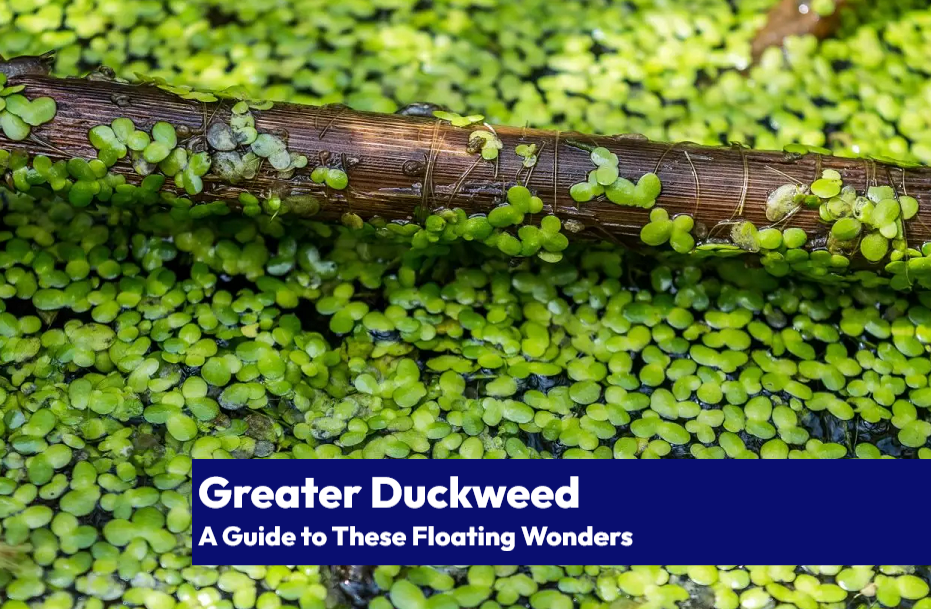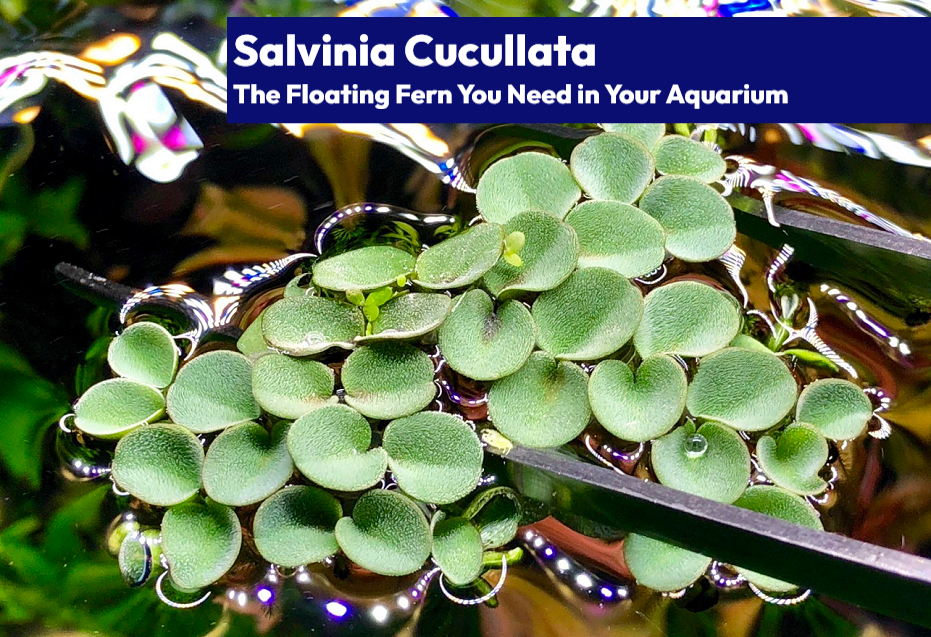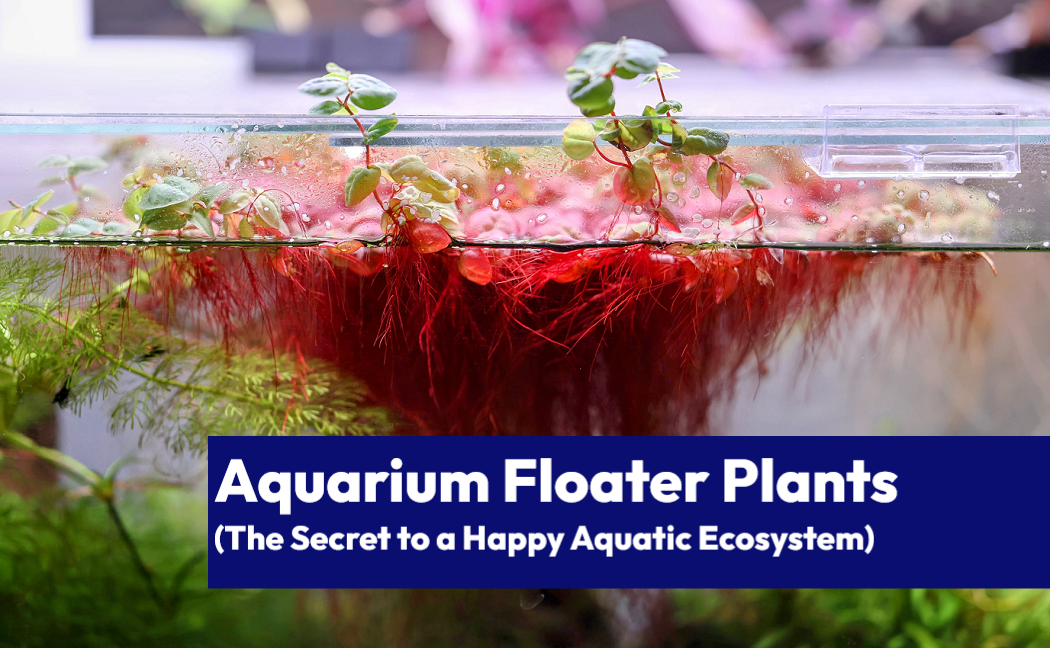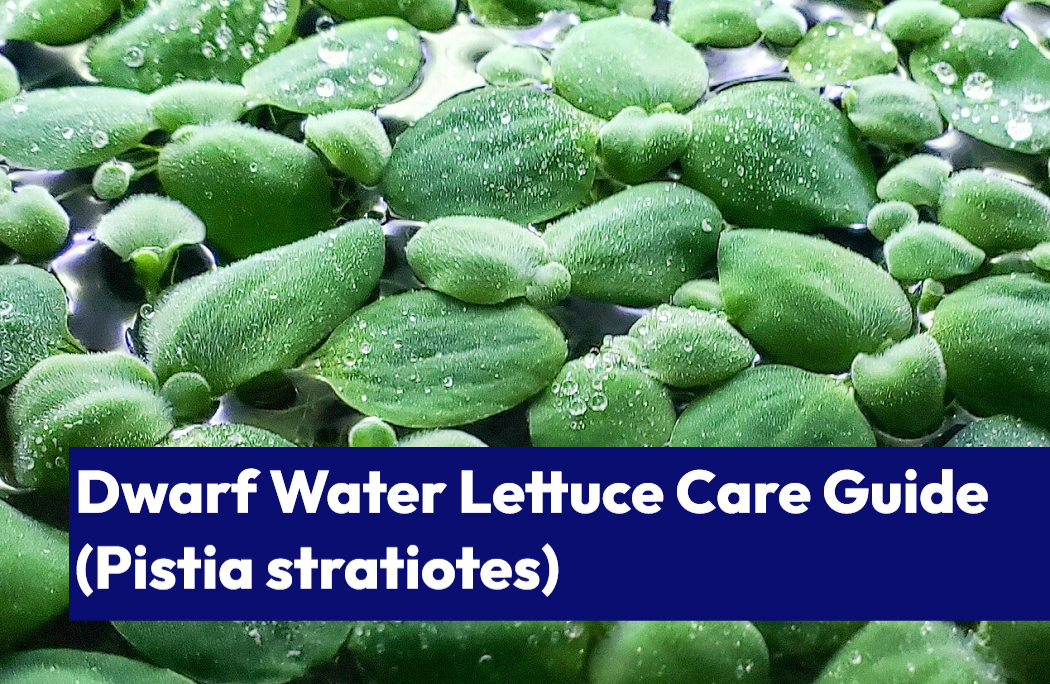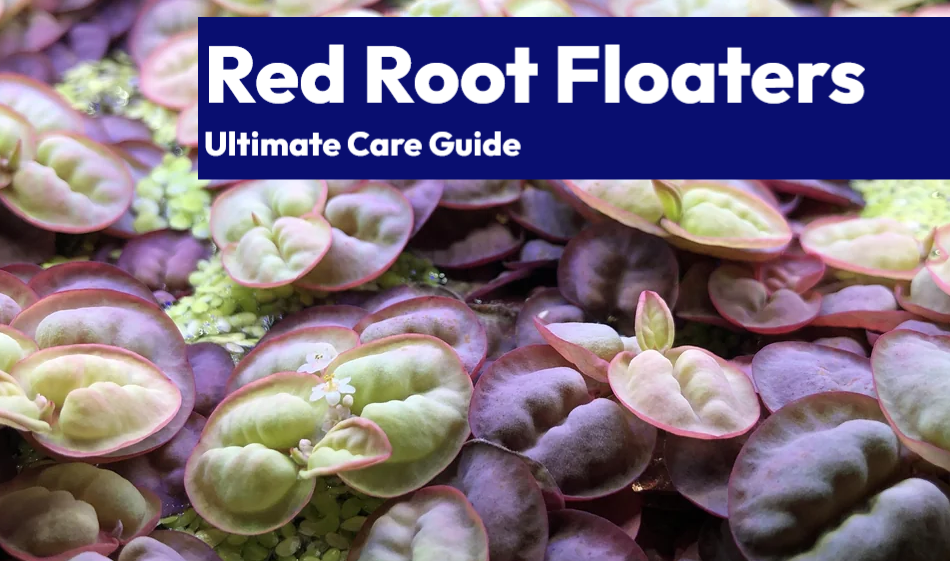Welcome, fellow aquascapers, to another fun-filled adventure through the depths of aquatic plants. Today, we’ll dive deep into the world of Greater Duckweed (Spirodela polyrhiza), a fantastic little plant that’s both easy on the eyes and great for your aquarium. Buckle up, because we’re going on a wild ride! 😄
The Duckweed Lowdown
Greater Duckweed, also known as Spirodela polyrhiza, is a small, floating aquatic plant that’s so charmingly tiny, you might mistake it for green confetti sprinkled on your aquarium’s surface. But don’t let its small size fool you – this little plant packs a punch when it comes to benefits for your aquatic friends.
Not only does it provide shelter for fish and invertebrates, but it also absorbs excess nutrients in the water. Talk about a win-win! Let’s dive into some crucial care data for our beloved Greater Duckweed.
| Care Data | Greater Duckweed |
|---|---|
| Scientific Name | Spirodela polyrhiza |
| Type | Floating |
| Growth Rate | Fast |
| Temperature Tolerance | 41-86°F (5-30°C) |
| Optimum Temperature | 64-77°F (18-25°C) |
| General Hardness | 4-20 dGH |
| Carbonate Hardness | 2-8 dKH |
| Optimal pH Range | 5.0-8.0 |
| Carbon Dioxide | Low-Medium |
| Nitrate | < 50 ppm |
| Phosphate | < 2 ppm |
| Potassium | 5-30 ppm |
| Iron | 0.01-0.3 ppm |
| CO2 Requirement | None |
| Propagation Type | Fragmentation |
| Placement | Floating |
| Difficulty | 1 (Incredibly Easy) |
The Science Behind the Name
Spirodela polyrhiza is the scientific name for Greater Duckweed, and like a fine wine or a top-notch cheese, its name carries a certain air of sophistication. The genus Spirodela comes from the Greek words “speira,” meaning coil or spiral, and “delos,” meaning visible or conspicuous. This refers to the plant’s coiled, spiraling roots that are easily visible beneath the water’s surface. As for “polyrhiza,” it translates to “many roots” in Greek, which is pretty self-explanatory. So, the next time you’re admiring your Greater Duckweed, you can impress your friends with some fancy botanical trivia! 🤓
A Closer Look: That Green Goodness

Greater Duckweed has a simple yet eye-catching appearance. Its small, flat, and round to oval-shaped leaves, called fronds, float on the water’s surface, creating a beautiful green carpet. Each frond is about 0.12-0.24 inches (3-6 mm) in diameter and features a slightly glossy surface that’s smooth to the touch.
But wait, there’s more! The fronds are light to dark green, sometimes with a reddish tint on the underside. The color intensity depends on the lighting and nutrient conditions. And if you look closely, you’ll notice a few delicate, thread-like roots dangling from each frond. These roots don’t anchor the plant to the substrate – they’re simply there to absorb nutrients and provide a hiding spot for critters.
Advanced Description
Greater Duckweed has a thallus (the plant’s body) that’s small, ovoid, and slightly convex. The plant is generally 3-6 mm long, 2-5 mm wide, and up to 1 mm thick. It has one to several simple, unbranched roots, with a length of 0.39-1.57 inches (1-4 cm), extending from the thallus’s central part. The upper epidermis has a thick cuticle and stomata, while the lower epidermis is thin and lacks stomata.
Size Matters: How Fast Does It Grow?
Greater Duckweed is known for its rapid growth rate. Under optimal conditions, this little plant can double its biomass in just 48 hours! That’s faster than you can say “quack-quack!” 🦆 This speedy growth is excellent for providing cover for fish and invertebrates, as well as sucking up excess nutrients in the water. However, it also means you’ll need to keep an eye on it and trim it back regularly to prevent it from overtaking your tank.
The average size of an individual Greater Duckweed frond is quite small, typically between 0.12-0.24 inches (3-6 mm) in diameter. However, when allowed to spread freely across the water’s surface, it can quickly create an impressive and dense mat of greenery.

Difficulty Level: Easier Than Learning to Tie Your Shoes
On a scale of 1 to 10, with 1 being “Incredibly Easy” and 10 being “Impossible,” Greater Duckweed earns a solid 1. Seriously, this plant is so easy to grow, it might just grow in your cup of coffee if you leave it unattended for too long. It’s incredibly adaptable, thriving in various water conditions, lighting, and nutrient levels. If you’re new to the aquarium hobby or just want a low-maintenance plant that looks great and benefits your tank, Greater Duckweed is the way to go.
A True Aquatic Superhero: Aquarium Benefits
Greater Duckweed isn’t just a pretty face. It also provides some fantastic benefits for your aquarium, such as:
- Shelter: This floating plant creates a dense canopy that provides shelter and security for fish and invertebrates. It’s especially great for surface-dwelling fish and shy critters who appreciate a little extra cover.
- Nutrient Absorption: Like a sponge, Greater Duckweed absorbs excess nutrients in the water, including nitrates, phosphates, and ammonia. This can help reduce algae growth and improve overall water quality.
- Oxygenation: As a floating plant, Greater Duckweed is in direct contact with the air, allowing it to absorb CO2 and release oxygen. This can improve oxygen levels in your tank, which is essential for your aquatic friends’ health.
💡 Pro Tip: Just be sure to keep the plant’s rapid growth in check, as it can block light from reaching submerged plants if left unchecked.
Size Matters: Tank Size Requirements
Greater Duckweed is well-suited for a wide range of aquarium sizes, from nano tanks to large, spacious setups. However, due to its rapid growth, it’s essential to monitor and trim it regularly, especially in smaller tanks where it can quickly cover the entire water surface. This will help ensure that your other plants receive enough light and that your tank’s oxygen levels remain balanced.
H2O Parameters: A Flexible Plant for Your Aquarium
Greater Duckweed is a highly adaptable plant, able to thrive in a wide range of water conditions. However, for optimal growth and health, aim for the following water parameters:
- Temperature: 64-77°F (18-25°C)
- pH: 5.0-8.0
- General Hardness (GH): 4-20 dGH
- Carbonate Hardness (KH): 2-8 dKH
Although Greater Duckweed can tolerate fluctuations and less-than-ideal conditions, it’s essential to maintain stable water parameters for the health of both the plant and your aquatic inhabitants.
Let There Be Light: Lighting Requirements
Greater Duckweed is pretty easygoing when it comes to lighting. It can grow under low, medium, or high light levels, making it a versatile choice for various aquarium setups. However, the plant will grow faster and more robust under medium to high light conditions. Just be careful not to overdo it – too much light can lead to excessive growth, which may require more frequent trimming and maintenance.
💡 Fun Fact: If you notice the underside of the leaves turning reddish, it’s usually a sign that the lighting is a bit too intense. You can either reduce the light intensity or increase the distance between the light source and the water’s surface.
CO2: Do They Need It?
One of the many things that makes Greater Duckweed a fantastic beginner plant is that it doesn’t require additional CO2 supplementation. The plant can obtain all the CO2 it needs from the air, thanks to its floating nature. This means you can grow Greater Duckweed without any fancy CO2 injection systems, making it an affordable and low-maintenance choice for your aquarium.
Planting Greater Duckweed: Easier Than Pie
Planting Greater Duckweed in your aquarium is a breeze. Just follow these simple steps:
- Acquire healthy Greater Duckweed plants from a reputable source.
- Gently rinse the plants with dechlorinated water to remove any debris or potential hitchhikers.
- Carefully place the plants on the surface of your aquarium, spacing them out a bit to give them room to spread.
- Sit back and watch your Greater Duckweed flourish!
Floating in Style: Tank Placement
As a floating plant, Greater Duckweed should be placed on the water’s surface, where it will create a beautiful, dense canopy. It’s best to give it some space to spread, so avoid placing it too close to filter outlets or other water disturbances, which may cause the plants to become submerged or tangled. Remember, proper tank placement will allow your Greater Duckweed to thrive and provide shelter and shade for your aquatic friends.

Feeding Time: Fertilization
Although Greater Duckweed is a nutrient sponge, absorbing excess nutrients from the water column, it may still benefit from occasional fertilization. Adding a liquid all-in-one fertilizer containing essential macro and micronutrients can help ensure your Greater Duckweed stays healthy and vibrant. Just be sure to follow the manufacturer’s recommendations for dosing to avoid over-fertilizing, which can lead to water quality issues.
A Trim and Tidy Tank: Maintenance & Pruning
One of the few challenges of keeping Greater Duckweed is managing its rapid growth. Regular maintenance and pruning will keep your floating plant in check and ensure that it doesn’t block too much light from reaching your submerged plants. To trim Greater Duckweed, simply remove a portion of the plants from the water’s surface using a fine mesh net. Be sure to dispose of the removed plants responsibly, as they can become invasive in natural waterways.
💡 Important: Never release aquarium plants, including Greater Duckweed, into local waterways, as they can become invasive and harm native ecosystems.
Trouble in Paradise: Growth Problems & Deficiencies
While Greater Duckweed is generally a robust and hardy plant, it can sometimes experience growth problems or deficiencies. Common issues include:
- Yellowing or browning leaves: This can be a sign of nutrient deficiency, particularly nitrogen, phosphorus, or potassium. Adding an all-in-one liquid fertilizer can help address these issues.
- Slow or stunted growth: This may be due to insufficient lighting or nutrient deficiencies. Ensure your lighting is adequate and consider adding a liquid fertilizer to boost nutrient levels.
- Excessive growth: Too much light or an overabundance of nutrients can cause Greater Duckweed to grow out of control. Reduce lighting intensity or duration and keep an eye on nutrient levels to keep growth in check.
Plant Parenthood: Propagation
Propagating Greater Duckweed is a piece of cake! As the plant grows and spreads across the water’s surface, new fronds will naturally develop and break away from the parent plant. You can help speed up the process by manually dividing larger fronds into smaller clusters and spreading them across the water’s surface. In no time, you’ll have more Greater Duckweed than you know what to do with!
Quarantine & Disinfection: Safety First
As with any new plant addition to your aquarium, it’s crucial to quarantine and disinfect Greater Duckweed before introducing it to your tank. This will help prevent the introduction of pests, parasites, or diseases that could harm your aquatic inhabitants. To disinfect Greater Duckweed, follow these steps:
- Prepare a disinfection solution, such as a diluted bleach solution (1 part bleach to 19 parts water) or potassium permanganate solution.
- Rinse the plants thoroughly with dechlorinated water.
- Soak the plants in the disinfection solution for 1-2 minutes, then rinse them again with dechlorinated water.
- Finally, place the plants in a quarantine tank or container for at least one week before introducing them to your main tank.
Origin Story: Native Range
Greater Duckweed is native to a wide range of regions, including North America, Central America, South America, Europe, Asia, and Africa. It can be found in various water bodies, such as ponds, lakes, marshes, and slow-moving rivers, where it forms dense mats on the water’s surface.
Taxonomy Time
Here’s a quick look at the taxonomy of Greater Duckweed:
| Kingdom | Plantae |
|---|---|
| Phylum | Streptophyta |
| Class | Liliopsida |
| Order | Alismatales |
| Family | Araceae |
| Genus | Spirodela |
| Species | Spirodela polyrhiza |
Wrapping It Up
In conclusion, Greater Duckweed is a fantastic addition to your aquarium, offering numerous benefits and requiring minimal care. It’s a versatile and adaptable plant that’s perfect for both beginners and experienced aquarists. Just be sure to keep its rapid growth in check and enjoy the vibrant green canopy it creates in your tank.
TL;DR
- Greater Duckweed (Spirodela polyrhiza) is a floating aquatic plant.
- Ideal for beginners and experienced aquarists alike.
- Offers numerous aquarium benefits, such as nutrient absorption and shade for inhabitants.
- Grows rapidly and easily propagates.
- Doesn’t require CO2 supplementation and can thrive under various lighting conditions.
- Maintenance involves regular trimming and monitoring of water parameters.
- Be sure to properly quarantine and disinfect before introducing to your aquarium.

Tim Priest, a renowned aquarium expert with over 15 years of experience in aquatic gardening and fish education, is dedicated to helping enthusiasts create stunning and thriving aquatic environments. As the founder of LearnTheAquarium.com, Tim shares his wealth of knowledge, passion, and expertise through engaging articles, educational resources, and personalized advice.
Discover the secrets to creating captivating underwater landscapes and maintaining healthy aquatic ecosystems. Join Tim on an exciting journey and let your aquarium adventure begin!
